
The West Hollywood Historic Preservation Commission on Wednesday will be asked to designate as cultural resources three clubs — the Roxy Theatre, the Rainbow Bar and Grill, and the Whisky a Go Go – that were major contributors to the rock ‘n roll history of the Sunset Strip. Also on its agenda is the nearby building at 9157-9163 Sunset Blvd., cited for its Streamline Modern design.
The Whisky and the Rainbow were owned by Mario Maglieri, who also managed the Roxy. Maglieri, who died in 2017, was part of a trio including Elmer Valentine and Lou Adler that transformed that part of Sunset from a center for burlesque and gambling to a place where rock legends like Elton John launched their careers.
Bands like Cypress Hill, Guns N’Roses, Motorhead and Led Zeppelin played and dined in those locations, which also featured performers such as the Doors, Jimi Hendrix, and Buffalo Springfield.
The Rainbow and the Roxy are owned by Roxy Theatre Corp. and the Whisky property is owned by M&M Media. The property at 8157-63 is owned by Sunset Place Building LLC. Memos from the city Planning & Development Services Department offer detailed descriptions of the history of the Roxy, Whisky a Go Go and Rainbow Bar & Grill, which WEHOville has reposted on the pages below.
Designation as a cultural or historic resource offers both pluses and minuses for building owners. On the plus side, they can qualify for benefits including less strict zoning requirements and a reduction of up to 50% in property taxes in exchange for rehabbing and preserving a building. On the minus side, an owner who plans to significantly alter or demolish a building designated as culturally significant must obtain a “certificate of appropriateness” if the designation is by the City of West Hollywood.
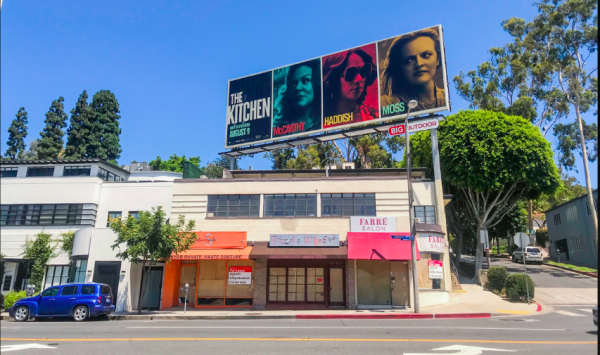
9157-9163 Sunset
The 9157-9163 Sunset building is a three-story structure on the northwest corner of Sunset and Cory Avenue. The top floors are office space and the ground level contains vacant retail spaces. It was designed by architect Ronald J. Webb and built in 1938 in the Streamline Moderne style.
In a memo to the Commission, the city’s Planning and Development Services Department recommends the designation, stating: “The property is a representative example of Streamline Moderne architecture that maintains its 1938 character-defining features, is associated with the history of commercial development along the Sunset Strip, and is one of the few remaining examples of the Streamline Moderne style architecture that helped define Sunset Boulevard as a sophisticated shopping and entertainment district.”
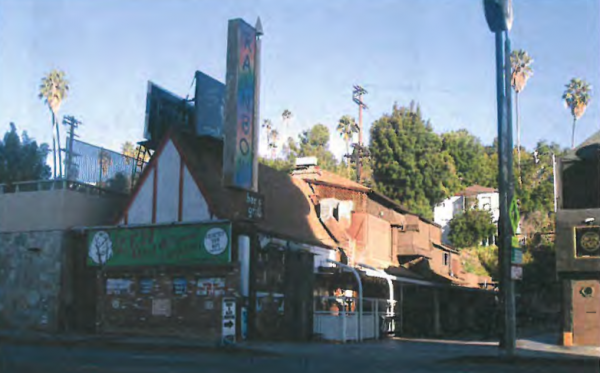
Rainbow Bar & Grill
The Planning Department recommends the cultural designation for the Rainbow Bar & Grill building for its association with the history of music and live entertainment in West Hollywood.” In explaining its significance, the Planning Department writes:
“The building that houses the Rainbow Bar & Grill was originally home to several European style cafés, which had become a mainstay of Sunset Strip development after the famous Russian Eagle Café opened in 1928. The first was The Queen, which opened for business in August 1935, followed by Café Esquire in 1936, and Ray Haller’s Mermaid Club in 1937. These early efforts at nightclub operations were short-lived not because they were unsuccessful, but rather because they were often too successful and led to raids and closures. The success of these earlier clubs proved that a nightspot could attract an audience at this location and following the closure of the Mermaid Club, the property finally found stability when it was eventually relaunched as the Villa Nova in 1940. After operating for 28 years, Villa Nova closed in 1968 and the building re-opened as the Windjammer until it closed in 1971.
“The Rainbow Bar & Grill opened in 1972 during a period of transition for Sunset Strip’s music scene, which by then was fueled by what appeared to be an unending supply of money that was attributed to the bounty reaped by the musicians who made it big amidst the pop-rock explosion of the 1960s and early 1970s. As the demand for live musical performances grew, performers began transitioning to larger venues, which equated to greater fees for the artist.

“The Sunset Strip was soon transformed by the conspicuous consumption culture and the celebration of good fortune to excess. While the younger generation embraced the excessive behavior exhibited by their favorite artists, musicians soon found that not even their money could buy them respect in the most established circles. Put off by their arrogance and debauchery, many of Hollywood’s established restaurants and bars refused to provide service to musicians and continued to cater only to movie stars and film studio executives.
“The idea for the Rainbow Bar & Grill came from band manager and public relations executive Bob Gibson, who wanted to establish an exclusive restaurant that catered solely to the excesses of rock ‘n’ roll because more traditional venues would not cater to musicians. He approached a few of his friends for support, including Lou Adler and his associates, Elmer Valentine and Mario Maglieri. These men then formed a group of investors from the music industry that, aside from them, included Gary Stromberg, Bob Regehr, Mich Ochs, Corb Donahue, Jerry Kellert, Roy Silver and Ted Flier. Altogether, the group collected $55,000 to purchase the Windjammer and set about executing their plan for a dedicated rock ‘n’ roll restaurant that would be an exclusive destination where the record industry could throw lavish parties free from judgment, and dress or conduct codes. Elmer Valentine and Mario Maglieri would oversee the day-to-day operations of the restaurant, which began receiving requests for reservations as soon as the news of its opening broke.
“The Rainbow Bar & Grill opened on April 16, 1972, with a party for singer Elton John. The following week the restaurant had a party for Rod Stewart, and the Rolling Stones thereafter. Before not too long, The Rainbow became the place to be. Ironically, it also became popular with the younger generation of actors. Up-and-comers like Dennis Hopper, Jack Nicholson, and Warren Beatty, all of whom were thought to be outsiders in the film industry, were often at the restaurant. For most of the 1970s, the Rainbow remained the exclusive domain of the rock ‘n’ roll elite. In the 1970s, Alice Cooper formed a drinking club with Keith Moon, Ringo Starr, Micky Dolenz, and Harry Nilsson called the Hollywood Vampires, and they were granted their own room at the Rainbow Bar & Grill. The location of the Rainbow next door to The Roxy Theatre and only a few blocks up the street from the Whisky à Go Go also helped to make it the destination of choice for musicians who wanted to celebrate a successful show. By the mid-1970s, even the parking lot at the Rainbow had its own scene with a crowd of up to 300 people each night.
“The continued success of rock ‘n’ roll music throughout the late 1970s and early 1980s ensured the success of the Rainbow. The regulars at this venue have included nearly every major rock ‘n’ roll star of the last four decades. Today, the Rainbow Bar & Grill continues to serve the next generation of rock ‘n’ roll stars and is overseen by Mikael Maglieri, who took over operations from his father.”
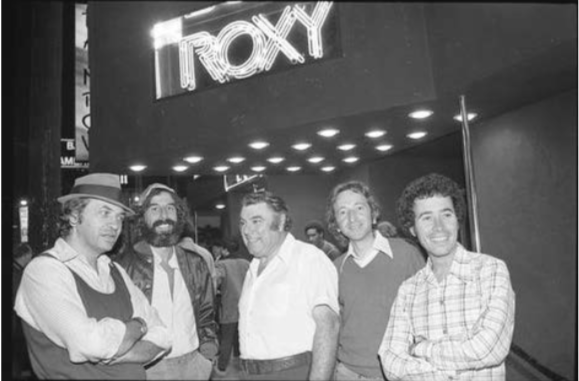
The Roxy Theatre
The Planning Department recommends the designation of the Roxy Theatre as a cultural resource noting its association with the history of music and live entertainment in West Hollywood. Its story of the history of the building is as follows
“The building that houses the Roxy Theatre was originally known as the Westside Market, which opened for business in 1938 and operated continuously for almost 20 years as several retail uses including a grocery store, bakery, liquor store, and fruit stand. In 1956, the building was leased to nightclub owner Chuck Landis, who converted the former market into a nightclub known as the Largo, which became an established presence on the Strip that operated until 1972.
“The Roxy Theatre debuted in 1973, during a period of transition for the Sunset Strip’s music scene that was still suffering from the after-effects of the 1966 ‘riot on Sunset Strip.’ This signaled an end to the feeling of optimism and free-spirited social consciousness that once characterized Sunset Strip, and the subdued atmosphere sparked a decline in development in the area. At the same time, as the popularity of rock & roll exploded in the late 1960s, the popular music scene evolved away from its intimate origins on Sunset Strip and live performances became more elaborate and more commercialized. Economic activity along the Strip languished as audiences migrated to larger venues, and the atmosphere of creativity and innovation dissolved as artists and performers found success and relocated away from the area.
“However, the early 1970s also proved to be an auspicious time for the establishment of a new music venue as audiences and record executives suffering from stadium fatigue were returning to more intimate live performance venues to seek out new talent. As a result, nightclubs gained renewed importance as showcases for the next generation of pop-rock stars. The development of the Roxy Theatre during this period represented a unique approach to the nightclub business that allowed the club to function unlike any other on Sunset Strip and offered the upstart Roxy several distinct advantages over existing venues.
“The original idea for the Roxy came from record executive Lou Adler, who was then the president of Ode Records. He joined forces with four other industry insiders who were uniquely positioned to develop the live performance experience for both the artists and their audience. They included fellow record executives Peter Asher (whose role was ultimately filled by Elliot Roberts from Elektra/Asylum Records) and David Geffen, head of Elektra-Asylum Records and a partner in the Geffen-Roberts management company. The three record executives were joined by two veteran nightclub operators including Chuck Landis, the aforementioned owner of the Largo, and Elmer Valentine, owner of the legendary Whisky à Go Go. The fact that three of the club’s five owners were record company executives played a critical role in developing the vision for The Roxy. As managers, their focus was on the talent, and from the start The Roxy was developed as a prestige showcase that would provide the best experience for the artist as well as the audience.
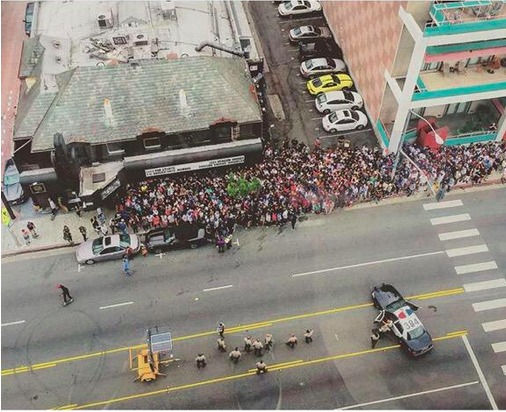
“The talent emphasis at The Roxy was originally to be on folk and soft rock, and on September 23, 1973, it hosted its grand opening with three nights of performances by Neil Young. The lineup that rounded out the club’s first year included Cheech & Chong, Jerry Lewis, The Temptations, Linda Ronstadt, Frank Zappa, and Genesis. The following year, The Rocky Horror Picture Show made its American debut at The Roxy on March 21, 1974, and ran for nine months, finally closing on January 5, 1975. This decision by Adler to successfully book a headlining stage show that was not a musical act signaled The Roxy’s plan to forge its own path on Sunset Strip.
“With its A-list headliners, it was just a few short years before The Roxy was hailed as the sweetheart of the music industry in Los Angeles. The club also hosted jazz, R&B, country, and some mainline pop musicians. By 1977, The Roxy had showcased performances by Joe Cocker, The New York Dolls, Billy Joel, Smokey Robinson, Bob Marley & the Wailers, Hall & Oates, Bruce Springsteen, Patti Smith, Robert Palmer, The Ramones, Lou Reed, Peter Gabriel, Etta James, and The Sex Pistols. Credited in large part to the industry influence of Adler, Elliot, and Geffen, the club’s ability to draw big-name performers completely dominated Sunset Strip.
“As the punk-rock scene propelled Sunset Strip into the 1980s, The Roxy continued to host more mainstream artists like Muddy Waters, Patti LaBelle, Stevie Wonder, and Aretha Franklin. It also presented a selection of edgy but talented newcomers like War, The Go Go’s, and The Clash. In 1981, the club also hosted another groundbreaking stage show, this time by a comedian named Paul Reubens, which marked the first significant public appearance of his eccentric character, Pee-wee Herman. One of his shows at The Roxy was taped by the television cable network HBO, which aired the performance as a special and introduced Pee-wee Herman to a national audience. Reubens went on to perform at The Roxy for an unprecedented five-month sold-out run.
“The Roxy eventually did return to booking rock & roll artists, and its popularity persisted through the 1980s and 1990s as club played host to groups such as Ratt, Guns N’ Roses, Jane’s Addiction, Agent Orange, Poison, Motley Crüe, System of a Down, Social Distortion, Red Hot Chili Peppers, and Pearl Jam. In 1998, Lou Adler turned the management of The Roxy over to his son Nic, who continues to oversee the club today.
“Within the 20-year period from 1964 to 1984 that generally characterizes the most active period of musical development on Sunset Strip, The Roxy was the only venue that was never subject to widespread criticism of its decline. Today, The Roxy is one of the few continuously operating venues dating from Sunset Strip’s heyday as a center for live musical performance.”
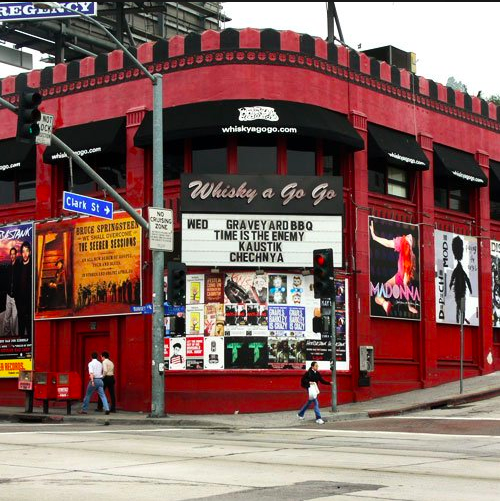
The Whisky a Go Go
The Planning Department memo recommends the cultural designation of Whisky a Go Go, noting “The property was constructed during the first wave of development of the Sunset Boulevard strip in the 1920s, has a unique location and considered an iconic image of the Sunset Strip, is a rare example of a smaller scale Art Deco style commercial building in West Hollywood, and became one of the most famous and significant music venues in rock ’n’ roll history as the Whisky à Go Go.” In its detailed explanation of the Whisky’s history, the memo states:
“The Sunset Strip is associated with two periods of significance that define its development and relationship to the growth of West Hollywood. The first era of development on the Sunset Strip occurred in the 1930s. The Sunset Strip was unincorporated county land surrounded by the City of Los Angeles and Beverly Hills. This entailed many advantages to development along the Sunset Strip. Development was more economically efficient on County land than in the neighboring incorporated City of Los Angeles. Building permits cheaper, development standards were more lax such as height limits, quality of materials, etc., and although the land was underdeveloped, it still had the benefit of established utilities and public services. The building that would eventually become the Whiskey à Go Go was developed in 1923 as a part of this wave of development.
“The Sunset Boulevard thoroughfare, referred to as the County Strip, was the most direct route for entertainment industry stars and captains to commute between the studios in Hollywood and their homes in Beverly Hills. This convenient location and lucrative development potential led to commercial development that attracted businesspeople like beauty specialists, agents, publicists, and managers to sprawl out to these convenient locations, along the Strip that became known as “agent alley.” With the repeal of Prohibition in 1933, the Sunset Strip experienced a rapid growth of nightclubs and entertainment venues that attracted Hollywood’s famous stars. The Sunset Strip was developed with popular nightclubs with famous headliners such as Nat King Cole, Frank Sinatra, and Mae West. The peak of Sunset Strip’s first period of significance is identified as 1941, after which many of the forces driving the activity on the Strip shifted to Las Vegas.
“Riddled with mobster violence in the 1940s, the Sunset Strip slowly and gradually declined as the hub of Hollywood glamor and nightlife.
“The Whisky à Go Go’s opening on January 15, 1964 defined the second period of significance for the Sunset Strip. Between 1964 and 1982, the Strip became a major center for musical creativity and live musical performances. The club’s founder, Elmer Valentine, a former Chicago cop with mob ties, opened the Whisky à Go Go with a business model inspired by French discotheques. The club famously featured female disk jockeys in a booth suspended from the ceiling. One of the female DJs started dancing between sets and the crowd’s positive reception to her dancing encouraged Valentine to construct two additional suspended cages for dancers. Joanie Labine, one of the dancers, designed the official go-go girl costume featuring a fringed dress and white boots. The Whisky à Go Go became a source for new forms of dancing, music, and cultural experience.
“With evolving cultural norms pertaining to age limitations, curfews, and segregation, the Whisky à Go Go was the leading hub for a counterculture movement on the West Coast. The Whisky à Go Go was a microcosm of the larger forces of the 1960s cultural revolution. The Sunset Strip went from a playground for the rich and famous to the frontline of a musical and socio-cultural revolution where the new youth mobilized to make their place in history. As these clubs paved the way for interracial connections, hosted shows starring African-American musicians, and attracted hundreds of teenagers and young baby boomers every night, the Sunset Strip became a controversial scene. As traditional figures attempted to curtail the rise of discotheque clubs by enforcing curfews, discontinuing liquor licenses, and arresting patrons, the Whisky à Go Go was the face of the Sunset Strip.”
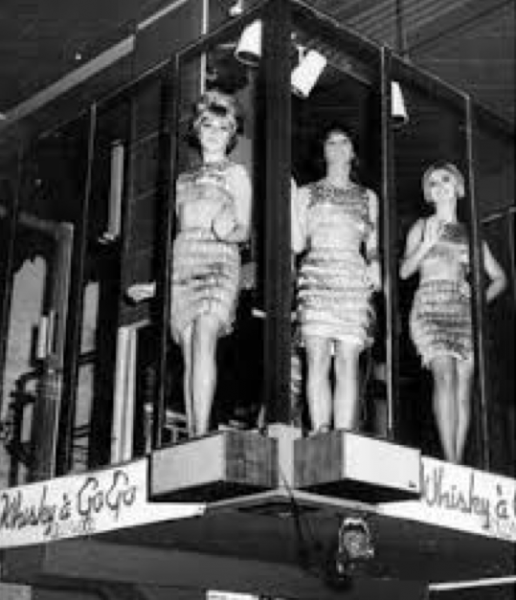
“The Sunset Strip Curfew Riots lasted for multiple days, consisting of demonstrations, marches, and stand-offs between the hippies and police. In the midst of the riots in November 1966, The County Board of Supervisors revoked the dance license for the Whisky à Go Go. This clash inspired Buffalo Springfield’s song, “For What It’s Worth.” Beyond its last influence on music, the protest and conflict attracted the attention and support of the American Civil Liberties Union and led to the formation of Community Action for Facts and Freedom. The riots signaled the end of the era of prominence of the Sunset Strip and the music epicenter transitioned to San Francisco.
“Through this era of change in the United States, the Whisky à Go Go was at the forefront as both a setting for these historical moments, but also as an active pioneer. Elmer Valentine, the famous founder and active owner of the Whisky à Go Go and other Sunset Strip nightclubs, is a critical figure in the development of the Strip and the Southern California music scene in general. It was his vision for the interior atmosphere and design of the Whisky à Go Go that appealed to the young Baby Boomers and pioneered a different type of nightclub that was replicated and popularized not only in other nightclubs, but in the media through TV shows like Hollywood A Go Go, Shindig, Hullabaloo, and Shivaree. And it was his skill for recognizing and supporting talent with which he curated a music scene that established the reputation of the Sunset Strip that exists to this day.
:The Whisky à Go Go was instrumental in the Sunset Strip’s second period of significance as a stage for the artists that would define rock ’n’ roll music as a genre and their audiences that would fuel the cultural movement.
“The transition reflected the rise of youth culture, which was characterized by a resistance to authority that contrasted with the conservative atmosphere of the preceding postwar period. Music was a central focus and mode of expression for this culture. The Doors, the house band at the Whiskey a Go-Go in 1966, were just one of the many rock bands that defined the era and established the reputation of the Sunset Strip as the center of the contemporary music scene. The Strip and nearby areas of West Hollywood became the center of West Coast rock music as it progressed from the 1960s through 1990s, spanning the eras of rock, folk, punk, glam, new wave, heavy metal, and grunge music. The Whisky à Go Go has become a rite of passage for musicians and music lovers the world over.”
The Historic Preservation Commission will meet at 7 p.m. Wednesday in Rooms 1 and 2 of the Plummer Park Community Center, 7377 Santa Monica Blvd. Parking is usually available for free in the lot in front of the building.

This IS A Treasured-History on THE STRIP!
Protecting It’s HISTORY n KEEPN IT-ALIVE!
Yep.
While there may have been a party for Elton John at the Rainbow, his professional music debut was at The Troubadour.
good to hear.